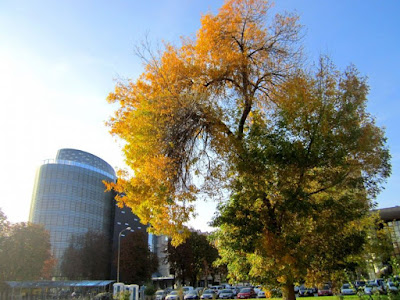 |
| (Photo by Jakupica) |
How the Tree Outside Your Window Helps You Save Money
Rachel Dovey
Trees, those leafy Earth Day symbols of environmentalism, already clean up the air and guard against soil erosion. Turns out, they also help cities cut down on both money and emissions by simply providing shade and blocking strong winds around buildings.
Those are among the findings of a new study from a group of USDA Forest Service scientists published in “Urban Forestry and Urban Greening,” which estimates that the U.S. supply of city trees saves close to $7.8 billion in reduced energy costs each year. The savings come from reduced electricity use (an estimated 38.9 million MWh annually) and heating costs. They also lead to a slash in emissions valued at $3.9 billion annually.
"... U.S. supply of city trees saves close to $7.8 billion in reduced energy costs each year. The savings come from reduced electricity use (an estimated 38.9 million MWh annually) and heating costs. They also lead to a slash in emissions valued at $3.9 billion annually".
How a tree affects its neighboring buildings’ energy use is, not surprisingly, a somewhat complicated science. While it might provide shade and cool the air in the summer (presumably saving on costs associated with air conditioning), it might also provide the same in winter, causing residents to turn up the heat. Researchers took this into account, considering where trees were located in relation to sunshine and wind speed, and whether they shed their leaves in winter. Ultimately, they combined field data on urban trees with local tree- and land-cover maps to get a countrywide estimate.
“There is much literature on tree effects on building energy use, but limited estimates at the national scale,” the researchers write. “There have been national estimates of energy savings from proposed plantings of millions of trees … but none could be found estimating the effects of the current urban forest.”
Certain states saw more energy savings than others — Florida, Texas and California topped the list with $643 million, $601 million and $410 million respectively. Researchers noted that focusing just on tree management in the country’s most densely populated areas, which make up about 3.6 percent of the U.S., would lead to significant savings.
But the takeaway of this study is not as simple as that old Earth Day slogan, “Plant a Tree.” Instead, cities should plant trees strategically.
“Tree size, species (evergreen vs. deciduous), and tree distance and direction from the building all affect building energy use,” according to the study. “While results vary by climate zone, in general, large trees to the west side of the building provide the greatest average reduction in cooling energy savings and large trees to the south side tend to lead to the greatest increase in winter energy use.”
Fonte: Next City





















Nenhum comentário:
Postar um comentário
Contribua. Deixe aqui a sua crítica, comentário ou complementação ao conteúdo da mensagem postada no Blog do Axel Grael. Obrigado.